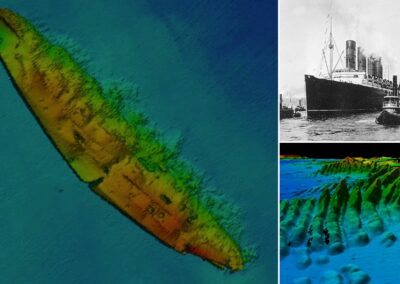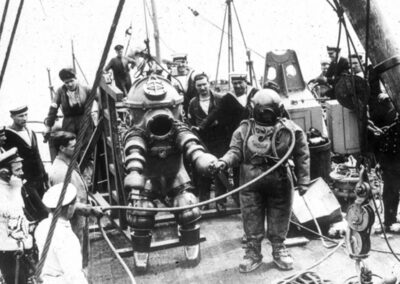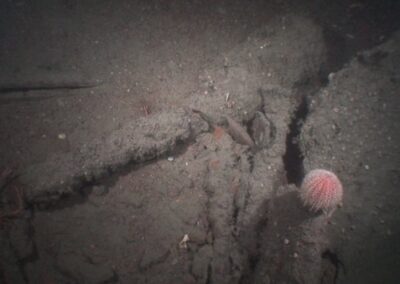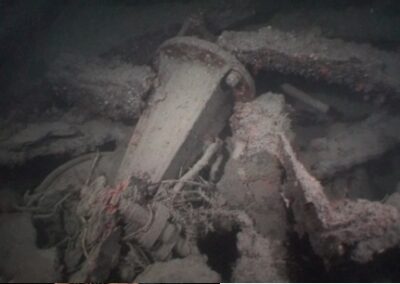Finding and Diving the RMS Lusitania
The RMS Lusitania was torpedoed and sunk by German U-boat, U-20, on May the 7th 1915. To this day the source of the second explosion, causing this magnificent passenger liner to sink beneath the waves in just 18 minutes, bringing with her 1201 men, women, and children, remains unsolved.
This tragic event took place just over 11 nautical miles [ approx. 21Km] off the Old Head of Kinsale in 300ft of cold, dark and frigid Atlantic waters. The Lusitania attracted the rich and famous. She was fast and so could transport valuable goods like the much-rumoured gold bullion [on westward trips maybe!] and priceless artwork along with the much-needed war material for the war effort across the Atlantic. So, the hunt was on to find the wreck to recover some of these rumoured valuables and commodities.
Several expeditions to find the wreck took place and on 6th October 1935. After three months of searching, the Lusitania was located. It was the crew of the salvage steamer Orphir – using a depth sounder – that found her just over 11 nautical miles out from the Old Head of Kinsale.
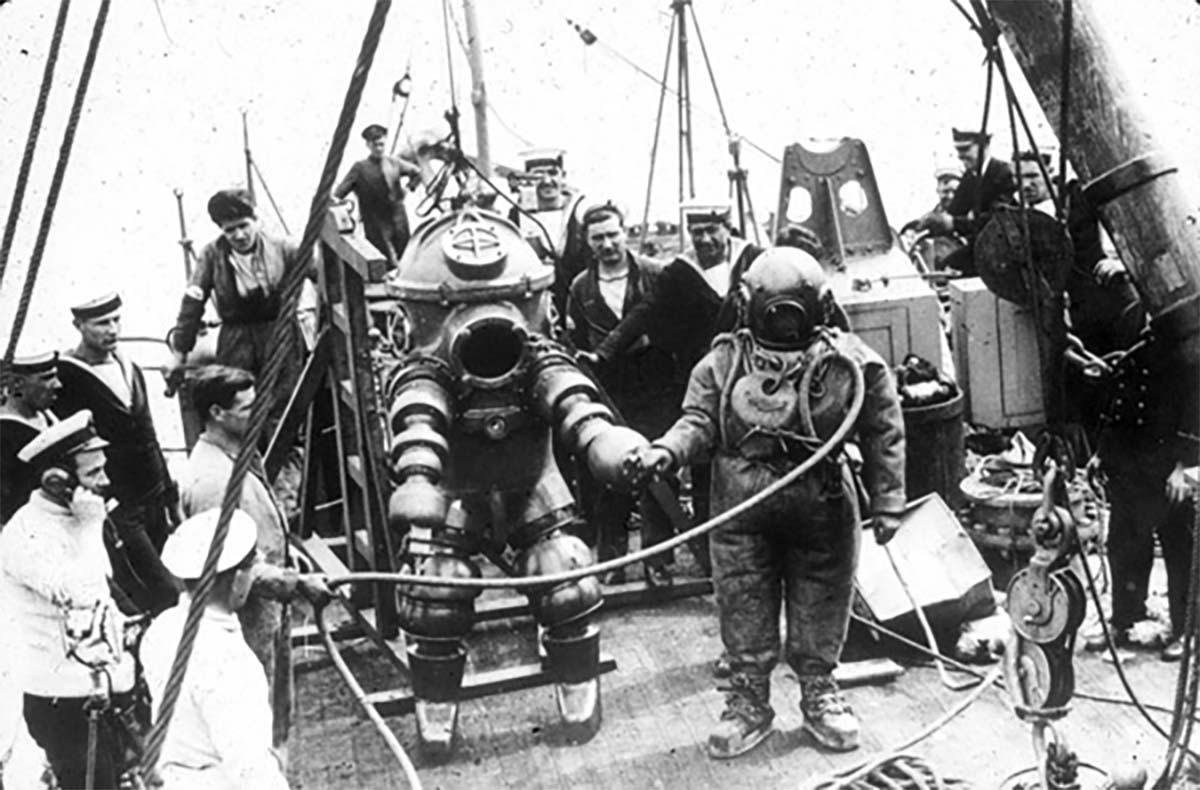
Diver Jim Jarrett wearing the Tritonia diving suit in 1935.
Nearly three weeks later diver Jim Jarrett was lowered to the wreck wearing the 1-atmosphere JS Peress Tritonia diving suit. The suit was designed by a British diving engineer Joseph Salim Peress and weighed an impressive half ton (1000 lbs). It was more than capable of resisting the intense pressure found at the wreck site, some 300 feet below the surface.
Since the discovery of the wreck, which at that point was in international waters, there have been many claims of activity over the wreck, but records do not exist for any such efforts or are at least quite vague in the details. We do not know what they intended to do or what they accomplished if anything. Sorima the Italian salvage company supposedly recovered the safes, but no proof is available. Risdon Beazley, another, and very prominent salvage company supposedly visited the site and then reported that the Royal Navy had their deep diving vessel the HMS Reclaim over the wreck, but these claims have not been verified.
The wreck has unexploded hedgehog mines strewn about where it’s claimed the British government tried to conceal or destroy any remaining unexploded ordnance on the wreck.
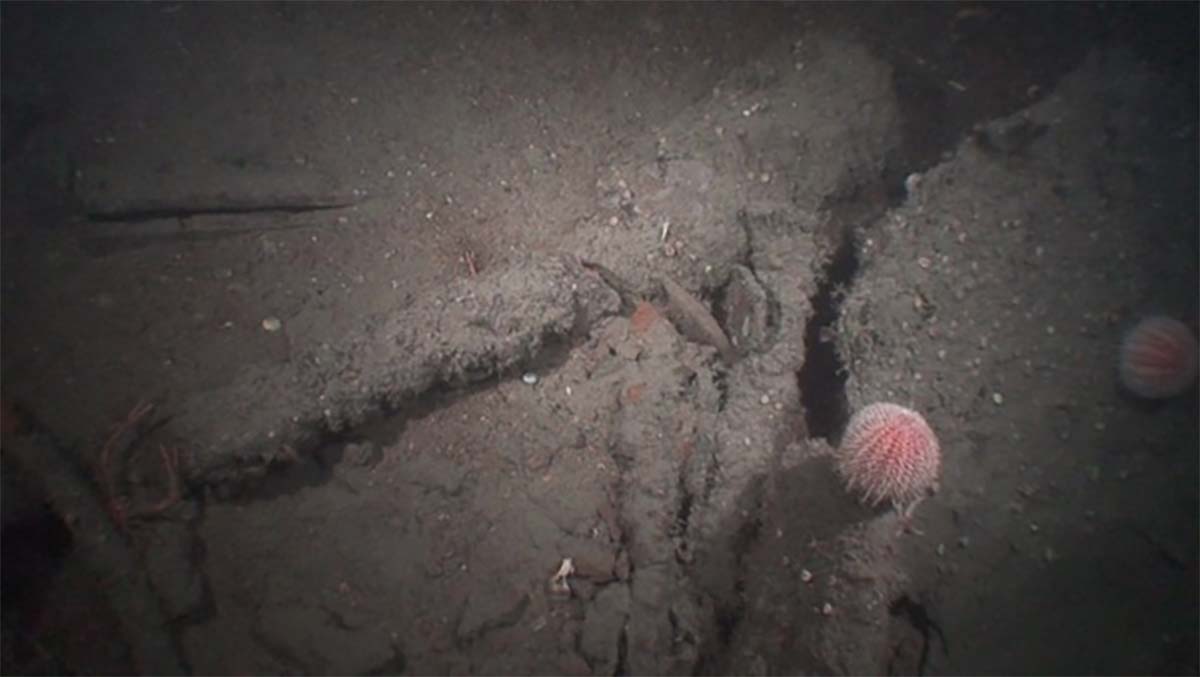
An unexploded depth charge on the wreckage.
John Light bought the wreck from War Risk Insurance for £1000, the low price indicated that rumours of gold aboard were untrue or simply beyond reach of the diving technology of the time.
John Light worked for several years on the Lusitania between 1957 and 1962. His purpose was to salvage the reported valuables that remained on the wreck. But the project ran into cost overruns and financial backing was withdrawn. This is when Gregg Bemis, who was one of the financial backers, became the sole owner of the wreck of Lusitania.
 Gregg then liaised with Oceaneering International Ltd, based in Houston, Texas, a company that specialised in commercial diving work using saturation divers. This was new technology that brought the deep wreck sites, deemed unsafe for divers using previous diving technology, within reach. This 1982 project was set up as a commercial venture where items salvaged by Oceaneering would be sold to fund their efforts. Lots of valuable items were recovered but the safes were missing (were they previously recovered?). Three of the four bronze propellers were recovered (the fourth lies buried under the wreck). One of the propellers is on display on the pierhead in Liverpool in front of the Maritime Museum as a Lusitania memorial; a second is on display in the Sculpture Garden of the Hilton Anatole Hotel in Dallas, Texas. The location of the third is unknown. There is a persistent rumour that this propeller was melted down and refashioned into expensive golf clubs, but neither the propeller nor any of the golf clubs have ever surfaced.
Gregg then liaised with Oceaneering International Ltd, based in Houston, Texas, a company that specialised in commercial diving work using saturation divers. This was new technology that brought the deep wreck sites, deemed unsafe for divers using previous diving technology, within reach. This 1982 project was set up as a commercial venture where items salvaged by Oceaneering would be sold to fund their efforts. Lots of valuable items were recovered but the safes were missing (were they previously recovered?). Three of the four bronze propellers were recovered (the fourth lies buried under the wreck). One of the propellers is on display on the pierhead in Liverpool in front of the Maritime Museum as a Lusitania memorial; a second is on display in the Sculpture Garden of the Hilton Anatole Hotel in Dallas, Texas. The location of the third is unknown. There is a persistent rumour that this propeller was melted down and refashioned into expensive golf clubs, but neither the propeller nor any of the golf clubs have ever surfaced.
Additional valuable items recovered in 1982 include: two anchors (location unknown); the foghorn; one bridge telegraph; the ship’s bell and many delph and cutlery items.
Robert Ballard also visited the wreck in 1993 where his much-disputed coal dust explosion theory was formed. This aired on National Geographic in 1994. Shortly after this and with the advances in technical diving using helium, a team of British divers who didn’t have the owner’s permission claimed they saw the Hugh Lane priceless artwork that was reputedly onboard. These unfounded claims led to a Heritage Order being placed on the wreck by the Irish Government which led to several years of litigation for owner Gregg Bemis. Gregg had to contest his ownership rights in three separate countries.
 Since then, many technical divers have visited the wreck, resulting in some .303 bullets being recovered in 2008. In 2011 National Geographic made a documentary called ‘Dark Secrets of the Lusitania’ which investigated the many theories surrounding the second explosion. A subsequent dive after the documentary, led by Irish diver Eoin McGarry, made some significant recoveries from the wreck. These items are destined for the new Lusitania Museum on the Old Head.
Since then, many technical divers have visited the wreck, resulting in some .303 bullets being recovered in 2008. In 2011 National Geographic made a documentary called ‘Dark Secrets of the Lusitania’ which investigated the many theories surrounding the second explosion. A subsequent dive after the documentary, led by Irish diver Eoin McGarry, made some significant recoveries from the wreck. These items are destined for the new Lusitania Museum on the Old Head.
Divers continue to flock to this famous dive site that continuously reveals new and vital information about the wreck site…. watch this space and please give what you can so that the legacy of the RMS Lusitania can live on.
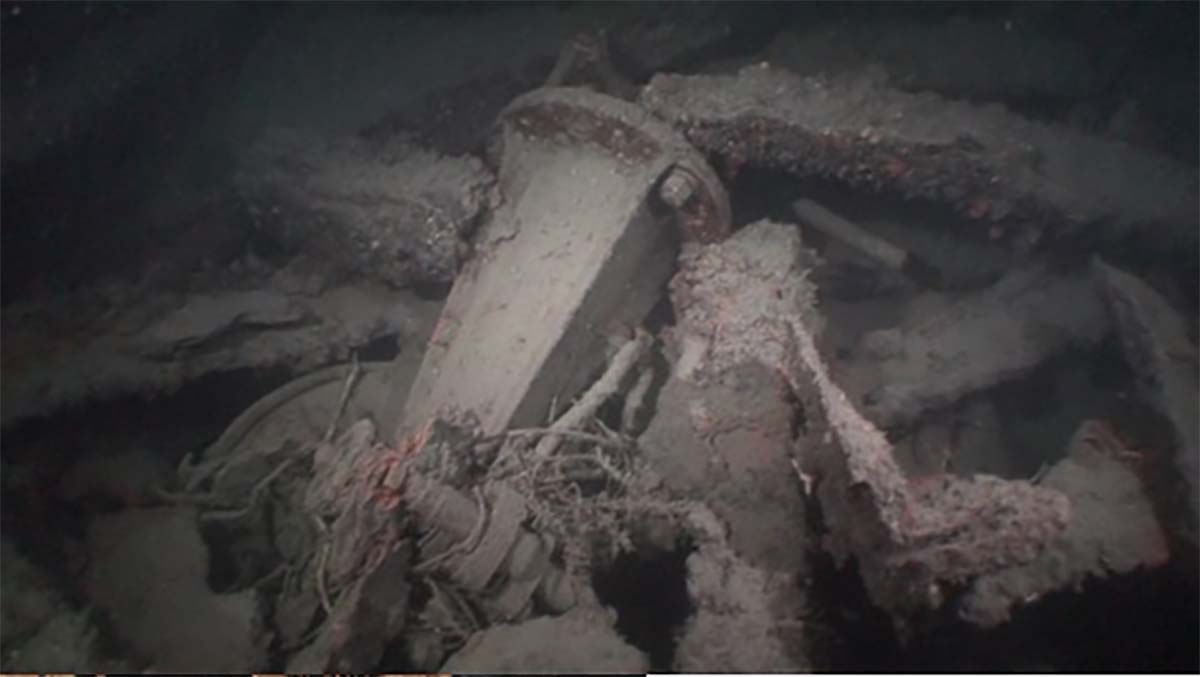
The second bridge telemotor that remains on the site.
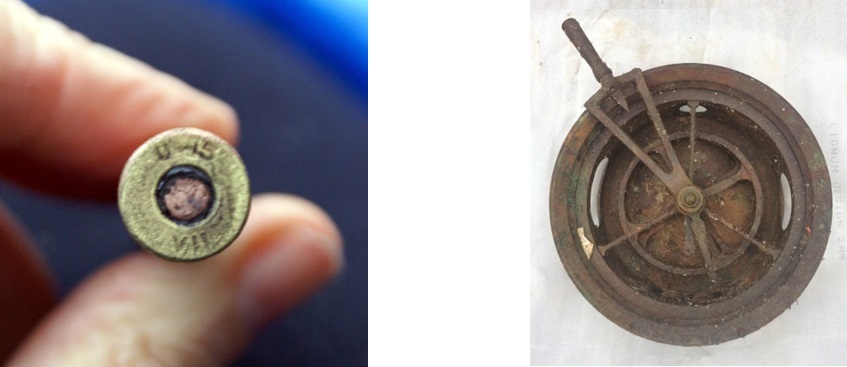
On the left: One of the .303 rounds recovered from wreckage in 2008. The marking yield vital information about where the rounds were made and who they were for.
On the right: a single-handed docking telegraph recovered in 2016.
Following construction of the Lusitania Museum at the Old Head, Friends of the Lusitania hope to fund the saturation dives needed to explore the wreck with a view to finding a definitive solution to the mystery of the second explosion. What caused the Lusitania to sink in eighteen minutes after a single torpedo strike, what was her cargo, to what extent was the sinking intentional, particularly what caused the second explosion in her forward cargo hold are still mysteries to be definitively answered. This will accord with the wishes of Gregg Bemis as contained in the MoU he signed with Irish Government. Such a project might involve using experienced U.S. oil rig saturation divers and/or former military divers trained in the U.S. and Ireland.
In accordance with the MoU, all advance planning for the project will entail the closest co-operation between the Lusitania Museum, who have the advice and expertise of Eoin McGarry, who has dived the Lusitania more often than anyone else, the Irish Underwater Archaeology Unit [UAU], the Irish National Monument Service [NMS], and the National Museum of Ireland [NMI].
In this aspect of our project, many legal and logistical concerns arise as the wreck is subject to a Heritage Order under Irish Law. While the Lusitania was originally in international waters she is now within Irish territorial waters under the current Law of the Sea. Everyone must also be supremely conscious that the wreck is a gravesite for many of the victims of the sinking of the Lusitania.
During the past decade there have been a series of annual dives, under Licence from NMS, on the wreck, resulting in the recovery of significant artefacts [some mentioned earlier] which will be displayed in the new Lusitania Museum at the Old Head Signal Tower. These annual dives have also provided evidence of the fast-deteriorating state of the wreck.
The plans to build a dedicated Lusitania Museum have also resulted in pledges of artefacts and memorabilia recovered from earlier dives and donated by relatives of the crew and passengers. In recent times, Mitch Peeke, one of the authors of The Lusitania Story [updated centenary edition], has donated memorabilia associated with William Thomas Turner, Captain of the Lusitania, who survived her sinking. These are invaluable historical items. Very recently, Lusitania Museum received a donation which we will call the Bemis Collection from the family of Gregg Bemis, who gifted the wreck of the Lusitania to the Museum on May 7th 2019. The collection contains sixty individual items which were recovered from the wreck in 1982. It includes fully intact plates, in quite remarkably good condition and cutlery marked with the Cunard Line logo. These are very poignant historical items. On May 7th 2022, Jackie McDougall- Wiener donated a very personal item, a money belt, of great personal sentimental value to be displayed in the Museum. This money belt was worn by Alice Midleton, Jackie’s grandmother during the sinking of the Lusitania. Alice, a young woman of 34 years of age in 1915, survived the sinking of the Lusitania and a period in the morgue in Cobh because she was rescued unconscious and thought to be dead. Alice subsequently lived a very full and fruitful life into her eighties. Lusitania Museum has also acquired a deckchair, courtesy of Padraig Begley, a member of our Committee and Senan Moloney, journalist and author of
‘LUSITANIA an Irish Tragedy’. This deckchair, with the Cunard logo, was taken from the sea within a few weeks of the sinking and is consequently in remarkable condition.
The relatives of Lusitania passengers and crew are exceptionally supportive of our plans as they have come to appreciate that the highest point of the beautiful Old Head peninsula, being the nearest point of land to the wreck, is the ideal location for a dedicated Lusitania Museum. They are also mindful of the obligation to keep the memory of all those lost, and indeed of all who travelled on the final Lusitania voyage, alive.
There is limited time remaining before the wreck collapses in on itself such is the speed of her deterioration. We are relying on the sympathetic appreciation of the public across the globe to help us while there is still time.
All dives on the Lusitania are prohibited without the express permission of the Lusitania Museum Old Head and a Licence from the National Monument Service.
– By Con Hayes and Eoin McGarry.

